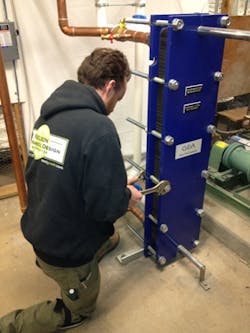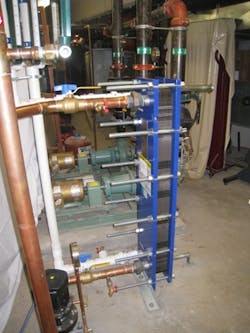Mansion Hotel uses displaced heat to warm swimming pool
VINEYARD HAVEN, MASS. — Old can be perceived many different ways. For example, calling another person old, not so much a compliment. But when you take a hotel, for example, “old” suddenly becomes more interesting — it exudes character, charm, quaintness, stories and experiences. It could be the single reason you choose to stay at one hotel over another. A fire burned down the 200-year-old Tisbury Inn here, established in 1791. The owners decided to rebuild in 2003, making the new and improved Mansion House Hotel one of Vineyard Haven's most desirable full-service inns. Transforming the old to new consists of adding comfort, adopting sustainable ideas, and saving some bucks along the way.
Fast forward nearly 10 years to 2012 when the hotel wanted to increase its energy efficiency and reduce energy consumption with a heating system. The Mansion House Hotel owners sought out the expertise and experience of Nelson Mechanical Design (NMD) to install an innovative heat exchanger that is projected to reduce the hotel’s fuel oil use by more than $13,000 annually. This savings is developed by a plate and frame heat exchanger that takes waste heat — essentially solar energy that has heated up guest rooms — and uses it to heat the swimming pool. The result is that the fuel oil-fired boilers will run much less, the pool will be heated indirectly by the sun, and the carbon footprint of the hotel will shrink dramatically.
“In December 2012, we installed a large plate and frame heat exchanger at the Mansion House Hotel to pull heat out of the building loop — generated at least 10 months of the year by all of the hotel's heat pumps — to heat the swimming pool, displacing $13,000 annually in fuel oil cost at $3.80 gallon,” said Brian Nelson, president of NMD.
The swimming pool is so deep that it is sitting in the aquifer. “An infrared Google Earth picture of the hotel would show a red streak running out of the hotel to the harbor as fuel oil is used to heat the pool — uninsulated — which then heats up the ground water as it runs under the pool,” said Nelson. This confirmed the suspicion that groundwater under the pool was constantly pulling heat out of the pool. Because the hotel's basement is so deep, and the pool is in the basement level, the entire pool is essentially sitting in the groundwater that runs underneath the hotel.
The outside-the-box thinking that Nelson Mechanical is known for came through on the Mansion House project, in the money-saving heat exchanger application, and a newly installed heat pump configuration. The swimming pool was originally heated solely by oil-fired boilers through a flat plate heat exchanger. Based on Nelson’s analysis of the energy going through this small heat exchanger, he discovered that the heat loss for the pool was 180,000 Btuh, a lot higher than he would expect just for evaporative loss from the pool surface. Now, the pool heat uses geothermal ground water using a GEA plate and frame heat exchanger with Grundfos CRE series circulators — not through a heat pump. “This pool installation continues our coupling of the building's heat load with the ground water by using the new heat exchanger to cool the building loop while it heats the pool,” said Nelson.
Nelson Mechanical installed hour meters on the existing pool heat exchanger circulator, the hot tub circulator, and the domestic hot water circulator in an effort to determine how fuel oil was used by the hotel. The analysis indicated that the pool was using about 8.6 gal./day of fuel oil or a bit over 3,000-gal./year.
“Fuel oil prices on the island have been fairly volatile, ranging from $3.80 to $5.00 per gallon. This meant that the hotel was spending up to $15,000 a year on pool heat,” said Nelson.
Thermal analysis
To find out how much heat was available in the building loop, Nelson looked at the trended data from the building automation system. This building loop is connected to the 48 guest room heat pumps, as well as 10 common area heat pumps. This inside building loop is connected to an outside 90-ton fluid cooler — with a groundwater geothermal spray system Nelson added previously — boosting cooling capacity to closer to 100 tons.
“If we used a plate and frame heat exchanger (instead of brazed flat plate), we could get close to a 2°F approach (the difference between the building loop temperature and the pool temperature), so if the loop was at 84°F, we could heat the pool to 82°F,” said Nelson. “The hotel's goal for pool temp was 82°F and above, so we mapped out how many months per year the building loop was above 84°F.”
As it turns out, over eight months the hotel could reliably get 84°F building loop temperatures, meaning that it could heat the pool using just the plate and frame heat exchanger during those eight months.
Further development of the building loop model data led Nelson Mechanical to propose a bypass valve for the building loop — normally all of the building loop water went outside to the fluid cooler and then back inside to the hotel. This meant that in the coldest months of the year, there was at least a 10-ton passive cooling effect on the building loop from the cold outside air cooling down the copper tube bundle in the fluid cooler. Installing a bypass valve in the building loop before the water left the building for the fluid cooler would keep the heat inside the building and would increase available heat for the pool heat exchanger.
“It turned out that we could add two more months of loop temperatures above 84°F to the heat available to the new heat exchanger, now over 10 months of the year, the loop would heat the pool instead of fuel oil,” said Nelson. “This boosted our projected savings to a bit over $13,000 per year.”
Building loop, pool loop
Using closely spaced tees, Nelson connected the building loop — flowing at 250-GPM — to the GEA plate and frame heat exchanger with StaRite (Pentair) pool-to-heat exchanger circulators, Webstone flanges and Apollo ball valves — flowing 75-GPM. Because the pool is salt water, the heat exchanger sheets are made of titanium. Poolside piping was Schedule 40 PVC pipe from Charlotte Pipe with Thomas Betts hanger struts.
At the pool loop connection, Nelson Mechanical installed two pairs of closely spaced tees due to the fact that water was continuously circulated from the pool through two filters and then back to the pool. The first set of tees sent water over to the new heat exchanger to heat it up to 82°F or higher. The second set of tees connected the pool water to the original brazed flat plate heat exchanger connected to the oil-fired boilers. A two-stage control looked at building loop temperature and turned on the new plate and frame geo circulator if the loop was 84°F and above and turned on the boiler heat exchanger circulator if the loop was below 84°F.Honeywell staging controls — for pool and boiler circulators — are used for both the geo heat exchanger and boiler heat exchanger.
The design that wasn’t
Initial plans called for the installation of a Mayakewa Eco Cute CO2 heat pump, which can actually replace oil boilers. Nelson and his crew worked tirelessly to develop a domestic hot water project based around the Eco Cute.
“The technical aspects are really interesting; to get the unbelievable COP of 5 and 197°F water, the incoming water to be heated had to be in the 70s or colder,” said Nelson. This meant that we had to engineer storage tanks versus multiple Eco Cute heat pump units to try to find the economic sweet spot for the hotel. We couldn't make the economic side work out — basically because the Eco Cute is not yet available in a size larger than 300,000 Btuh — for the Mansion House, but it will be a homerun for the right load.”
Nelson Mechanical wanted to use the heat pump to heat domestic hot water and displace a significant amount of the fuel oil use at the hotel. “The 197°F output made us think that we could meet the temperature requirements for the hot water system,” said Nelson.
Because it uses carbon dioxide as a refrigerant, there are restrictions on inlet water temperatures if high efficiency is desired — cold inlet water is necessary to fully cool the CO2 refrigerant as part of the transcritical refrigerant cycle. As the CO2 passes through the transcritical phase, its thermal conductivity spikes and efficiency rises very quickly. Essentially, this is the sweet spot for this refrigerant. But cold inlet water is necessary to make this happen to the CO2 in the heat pump.
The heat pump is similar to a tankless water heater in that the water goes through in a single pass — heated from 50°F coming in to 197°F going out. It means that the inlet temperature has to be really low. In a typical boiler heat exchanger scenario, the hot water temperature rises in the storage tank based on how many boilers are on. A single pass approach to heating water (as dictated by this Eco Cute heat pump) would require a lot of hot water storage tanks to get the high efficiency possible with this technology.
“The end result is that if the heat pump was close to the size of the domestic hot water load, it could run continuously with a constant input of 50°F water and achieve a COP of 5 and deliver 197°F water,” said Nelson. “But we couldn't make the economic side work out because the Mansion House domestic hot water load was about 900,000 Btuh and the Eco Cute is not yet available in a size larger than 300,000 Btuh.”
The GEA plate and frame heat exchanger has exceeded expectations. “It’s always a great thing when proposing a green solution to an energy problem,” said Nelson. “The hotel is surprisingly cooling dominant — high internal loads, lighting, guests, etc. — and we have had building loop temperatures in the high 80s when it is 35°F outside with all of the pool heat coming from the new heat exchanger.”
Because this project has been so successful and the thermal resource is so plentiful in the building loop, the hotel is considering Nelson’s next proposal: a plate and frame heat exchanger to tackle the pre-heat for the domestic hot water plant. “Our preliminary look at this project envisions a 1,000,000 Btuh heat exchanger saving almost 3,500 gal. of fuel a year! Definitely another ‘green’ project that makes real economic sense,” said Nelson.


